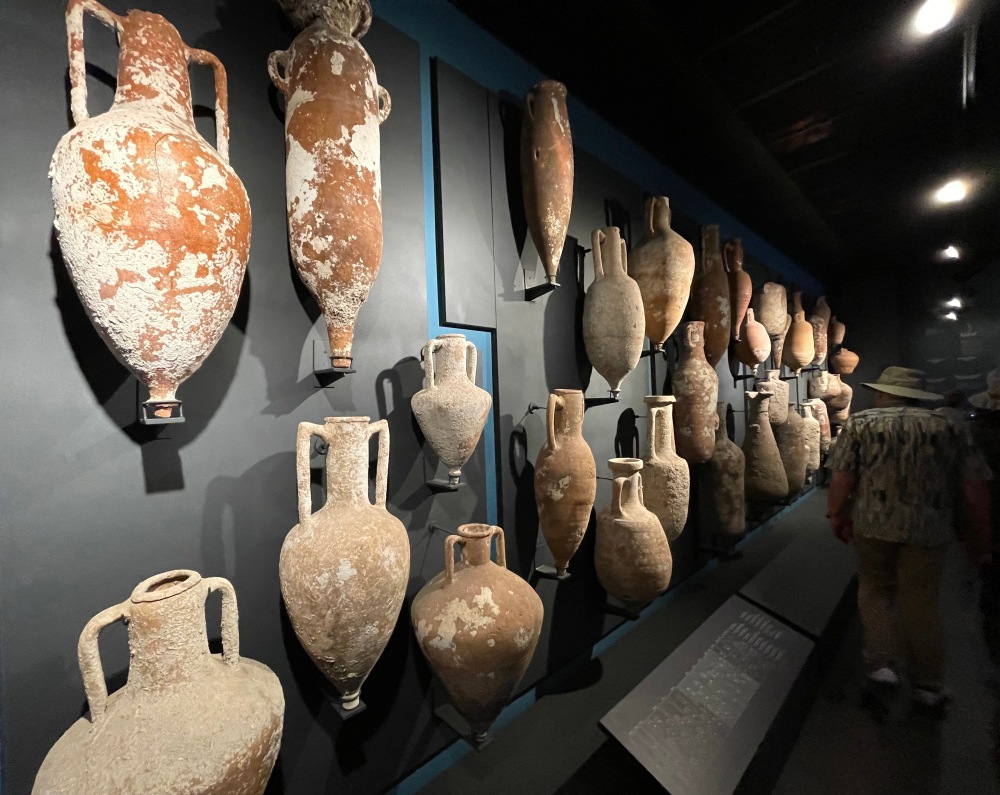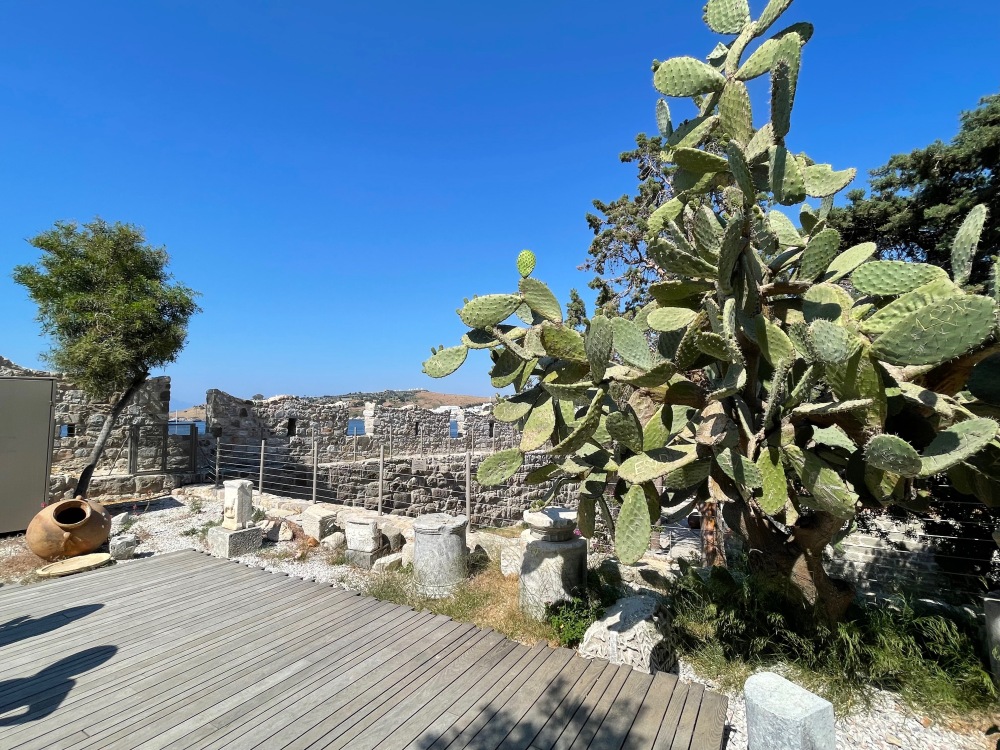Today, we are entering the castle! Finally! It now houses the Museum of Underwater Archeology and I was so excited because I wanted to learn more about those pots that were scattered here and there, all over the grounds of the castle! The pieces that I was most interested in, were the pointy bottomed ones called amphoras……..

An Amphora is a two-handled storage jar that held olive oil, grapes, wine, milk, fish or grain. Sometimes amphoras were used as grave markers or as containers for funeral offerings or human remains. There are two types of amphora: the neck amphora, in which the neck meets the body at a sharp angle or the one-piece amphora, in which the neck and body form a continuous curve. The necks of amphorae are narrow for pouring by a person holding it by the bottom and a handle. The size may require two or three handlers to lift it ( some amphorae have been as tall as 5 feet!)
For the most part amphora was considered tableware or sat close to the table. The pointed base allowed upright storage in soft ground, such as sand. The base also facilitated transport by ship, packed upright in little notched racks and roped together, to prevent shifting or toppling during rough seas, or on their sides, usually five layers deep. Heather and reeds were used as packing around the vases. The racks could later be used in the kitchen or shops. That narrow base also concentrated deposits from liquids with solid particles, such as olive oil and wines. Amphorae made from terra cotta, were too cheap and plentiful to return to their origin point, so when empty, they were broken up at their destination.
Noting that some amphorae were huge, some were less than 12 inches high, the smallest called amphoriskoi ( literally “little amphorae”) There was a standardization: the wine amphora held 41 quarts and was used as a unit of measure for liquids in the Roman Empire, called whatever else, but an amphora. We get our word “ampule” from this word too! I looked it up!
The amphorae were of great value to maritime archaeologists, as they often identified the age of a shipwreck and the geographic origin of the cargo. They were often so well preserved that the original content was still present providing information on foodstuffs and mercantile systems.

Roman amphorae were wheel-thrown terracotta containers. First, the body was made and then left partially to dry. Then coils of clay were added to form the neck, the rim, and the handles. After the amphora was complete the interior was treated with resin that would aid in preservation of stored liquids. Amphorae were also marked with a variety of stamps and inscriptions. They provided information on the product and content. It also indicated the name of the workshop or the name of the owner of the workshop. Painted stamps recorded the weight of the container and the contents and were applied after the amphora was filled. This stamping also allowed historians to track the flow of goods and recreate ancient trade routes. All that from one pot! Approximately, 66 types of amphora have been identified.

This photo shows the reconstruction of a ship and how the racks of amphorae were stored.

Here are the pieces of this Roman wreck, as it was found………

The Bodrum Museum of Underwater Archaeology was established in Bodrum Castle in 1964. Today, there are 14 exhibition halls including the German Tower, Amphoras Exhibition, the Dungeon, Carian Princess Hall, the British Tower, the Turkish Bath Exhibition, The Glass Wreak Hall, The Snake Tower, The Glass Hall, 4 shipwrecks and a Coin and Jewelry Hall. An aquarium has been set into the wall, which is a detailed model illustrating underwater excavation. (That is my Featured Photo! It makes you look like you are in the aquarium!)
The exhibits are in darkness with illumination from below. This is for better viewing of the various markings and colors of glass. Specimens are dated from the 14th century BC to the 11th century AD. The underwater excavations of the 4 shipwrecks were carried out under the direction of Prof Dr George Bass with money and technology from the University of Pennsylvania and Texas A&M. The wrecks were discovered in shallow water off the coast of Bodrum.


Now, let’s explore some more of the exhibits!

A set of scales……

And, then there was the Carian Princess……
An archaeology team came across the tomb during excavations of a neighborhood in Bodrum in 1989. Upon removing the lid of the sarcophagus, in the middle of a burial chamber, they found the skeleton of a 40 year old woman, 5 ft 3 inches in height, who had given birth to more than one child. She had her arms crossed and was adorned in gold jewelry. She also had very good teeth, noting a high standard of living. She is a Carian Princess to be sure, but there is ongoing research to prove she is Ada, the Carian Princess who lived between 360 and 325 BC. However, I like her history…….and want her to be in that tomb!
Her father, King Hecatomnus had three sons, Mausolus, Idrius, and Pixadarus and two daughters, Artemisia and Ada. When King Hecatomnus died Maulolis became king and married his sister, Artemisia, according to Carian laws. When they both died Ada, who was married to Idruis, were the rulers of Carias. After Idruis died Ada ruled alone. Paxadarus was mad because he could not inherit the throne (he could not marry a sister, there were none left, so he married outside the family) He plotted and fought to get rid of Ada. Eventually, Ada was exiled to the fortress of Alinda, where she continued to rule. When Alexander the Great entered Caria in 334 BC, sly Ada adopted Alexander, as her son, and surrendered Alinda to him. He accepted and in return gave Ada the command of the Seige of Halicarnassus or Bodrum. After the fall of Bodrum, Alexander made Ada, Queen of all of Caria and Ada made sure everyone remained loyal to Alexander! No more was recorded about Ada, from that time until 1989, when the tomb was discovered.

And, here was her gold crown…….

and some of her jewelry……….But, it is time to leave the Museum…….there is a lot to discover here and well worth the trip!

Back outside, we come upon these twosies……..two men and two peacocks.


and this fine fella came along too!

One more look down to the chapel/mosque and minaret…..

and out past the cactus to the sea……..


To a look of our ship………

And a great view of Bodrum!

I hope you have enjoyed Bodrum Castle and the Museum! We learned about Pots and Princesses, but we still have more to see, so we better get a move on! See you next time in another spot! Cady
PS I have included it with Jo’s Monday Walk, because I know Jo honeymooned here! If you would like to include your walk or see where others are walking today, stop by and see Jo!
This looks like a really well planned and presented museum. And you’ve done so much research! I can tell how much you were fascinated by these objects. My own favourites, as so often in such museums, are the jewellery pieces. I’m always taken by how wearable they look, even for today’s fashions, and I wonder about the women who once wore them.
LikeLike
I am not a big fan of museums……but this one was very interesting and several exhibits got my attention! The two I previewed were my favorites! Cady
LikeLiked by 1 person
Very interesting history! Thanks for writing about Bodrum.
LikeLike
Fascinating history of amphora! Now I understand why most of these jars had pointed bottoms. I relate amphora with the biblical account of Jesus changing water into wine at the wedding feast in Cana, His first public miracle, and those pointed-bottom jars or jugs — or, maybe, those had flat bottoms?
LikeLike
More than likely they were amphora!
LikeLiked by 1 person
I had no idea that there was so much to know about amphora, Cady. Thanks for the explanations and the tour. I have to apologise again that you haven’t made the cut this week, but I do have last week’s Bodrum post featured. I did wonder when you mentioned cacti as I didn’t remember any from that first post. If you comment you could leave a link, hon, then other people would see it and perhaps pop over. I’ll include this one next week. Thanks so much for your company.
LikeLike
Oh I guess I have been doing it wrong!!! Cady
LikeLike
No such thing as wrong! It’s just better if I know there’s a post. I didn’t see this one till this evening. No harm done. Sending hugs 💗🌺
LikeLike